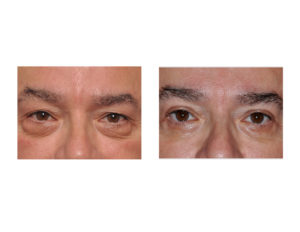While women used to be the dominant gender that had eyelid surgery, more and more men today are opting for it. Looking less tired and more alert casts a better image to others which is important from social interactions to one’s vocation and job opportunities. While getting good sleep, avoiding excessive sun exposure and not smoking are all extremely helpful, there is only so much one can do to prevent excess eyelid skin, lower eyelid bags and wrinkle lines from developing as time progresses.
Men age just as much around the eye area and, in many cases, may actually age worse than women. Men are particularly prone to excessive and hanging upper eyelid skin because their brows are often lower relative to the brow bone. Men tolerate lower brows so upper eyelid skin redundancy is often exaggerated. Men often develop large and prominent lower eyelid bags due to fat herniation. While historically men would not undergo blepharoplasty surgery until they have visual field obstruction, they are much prone today for earlier interventions before they develop functional issues.
While most of the technical aspects of blepharoplasty surgery are the same in men as women, there are noticeable variations between the two that should be considered. These include the aggressiveness of the eyelid surgery, the concomitant consideration of browlifting, avoiding postoperative lid retraction and dry eyes and the extent of recovery.


Due to thicker tissues and the common prevalence of high blood pressure in men, they will frequently have more swelling and bruising. They are also at higher risk of hematoma formation right after surgery due to spikes in blood pressure. Such swelling and bruising around the eyelids can be very noticeable for weeks. Men tend to be more impatient than women and should be counseled accordingly about the length of visible changes around the eye area. Pre- and postsurgical use of Arnica oral supplements and aggressive use of icing the first night of surgery can be very helpful.
The most common complication after blepharoplasty surgery involves the lower eyelid, regardless of whether it is a man or a woman. Avoiding any amount of lower lid retraction (ectrropion) requires good lateral canthal and orbicularis muscle support and minimal skin resection. While many older men have large amounts of excessive lower eyelid skin, it is important to resist the temptation to take too much. It may look fine on the operating table in the horizontal position but can turn out to be quite different after surgery as healing and scar retraction sets in. It is not important to try and make the lower eyelid wrinkle-free nor does it look natural that way either.
Dr. Barry Eppley
Indianapolis, Indiana


